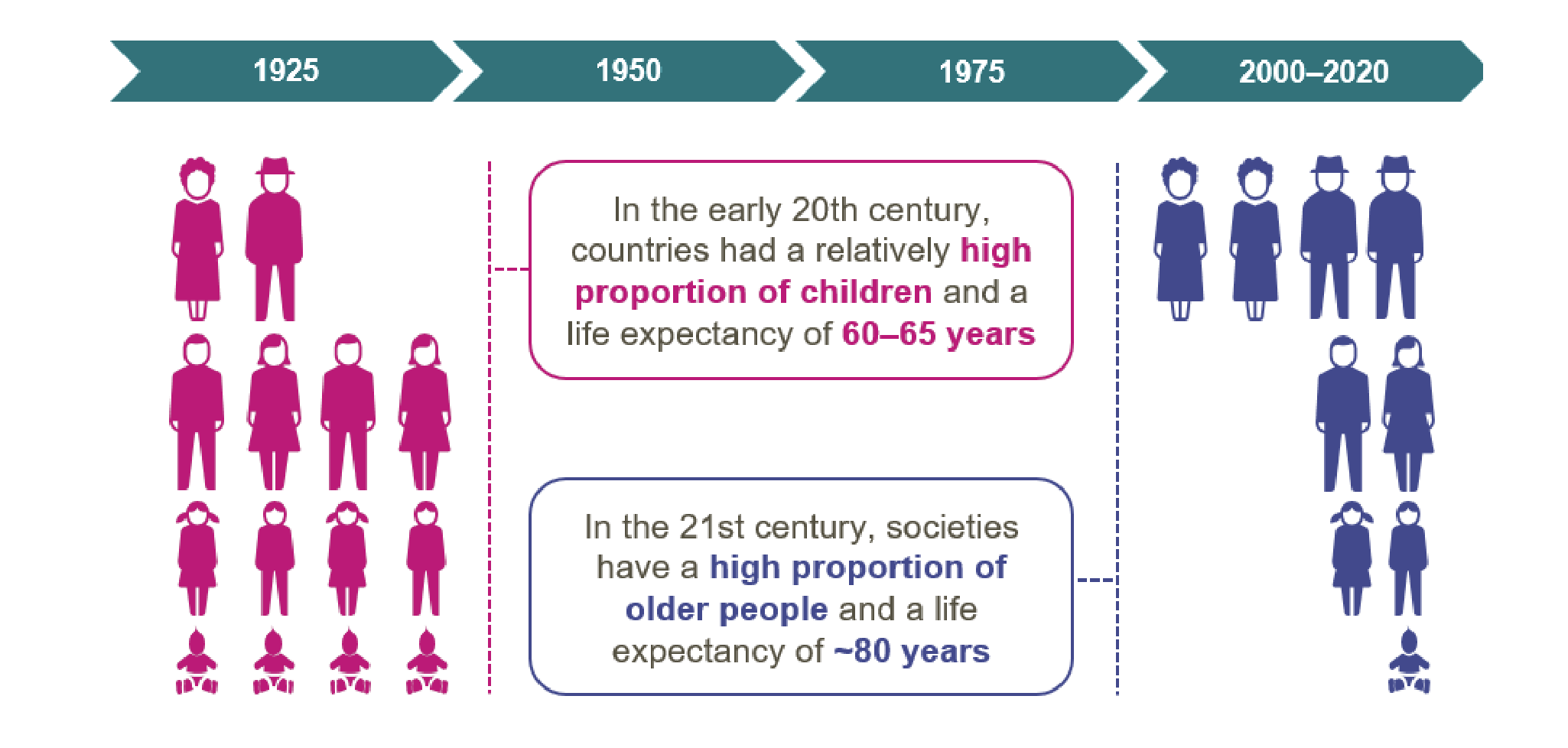
Building Adult Immunisation Back Better in the Wake of the Pandemic
Introduction
The impact of the Covid-19 pandemic has been devastating for all regions of the world including Europe. At the time of this writing, more than a million deaths in Europe had been attributed to the pandemic disproportionately impacting older adults and vulnerable people.1 The economic toll is also severe, with sharp decreases on GDP and other indicators2. Health systems across Europe have been heavily disrupted and these effects are expected to persist well beyond the pandemic period. Exiting this pandemic and reopening the economy requires the swift roll-out of vaccines and therapeutics across the world, both in the short-term and to possibly deal with what is to become an endemic virus. A successful recovery in Europe must also include a focus on prevention and healthcare delivery, including to specific target groups. This includes rebuilding and expanding routine immunisation, especially for older adults.
The mobilisation of national health systems in response to COVID-19 offers an opportunity to make policy choices that more accurately reflect the value of adult immunisation, to educate European citizens about the importance of vaccines for all ages, and to build a stronger life-course immunisation system.
People of all ages are vulnerable to infectious disease, including many infections that can be prevented by vaccines, but the youngest and the oldest are at greatest risk.3 In 2020, persons ≥65 years old accounted for approximately 20% of the European population, and this is expected to increase to approximately 30% by 2050.4 Common vaccine-preventable diseases (VPDs) affecting older adults in Europe include pertussis, influenza, pneumonia, respiratory syncytial virus (RSV) and shingles, among others. Adult immunisation programmes are important to reduce morbidity and mortality of VPDs and co-morbidities typically associated with ageing to compensate for age-related decline in immunity in older adults.5 For decades, European countries have implemented robust vaccination programmes for children, but significant gaps for adult immunisation programmes remain.6
Without concerted action, Covid-19 may widen these gaps. Around the world, this pandemic has caused patients and providers to delay most routine vaccinations, including for older adults for whom immunisation programmes were already absent or underperforming.7 For example, in the US vaccine billing claims for teen and adult vaccines plummeted between 66-86% during the early months of the pandemic compared to the same timeframe in the year prior to the pandemic.8 In Italy, vaccination coverage declined for various reasons including redeployment of staff normally employed in vaccination and public fear of accessing health services including for vaccination.9
Continued disruption of routine adult vaccination risks significantly setting back Europe’s progress in building stronger life-course immunisation systems. Moreover, the continued focus on Covid-19 vaccine roll out, whilst critical to exiting this pandemic, might further complicate or delay adult vaccination for other diseases.
Importance of immunisation for older adults
Classic vaccines like those for influenza and pertussis (“whooping cough”) remain highly valuable for reducing morbidity and mortality for older adults. Although the severity of influenza epidemics varies, in the years immediately prior to Covid-19, influenza was associated with as many as 152,000 deaths in a single year across Europe, approximately 80% of which were among older adults.10 Fortunately, influenza remained at bay during the 2020-2021 season due to lockdowns related to the pandemic,11 however, it is important to strive for achieving a 75% target vaccination rate among older people set by WHO, which few countries have achieved.12 Pertussis is a highly contagious respiratory infection, and despite widespread infant vaccination programmes, it remains one of the most poorly controlled VPDs, with resurgences continuing to occur every few years.13 Pertussis leads to a high burden on healthcare utilisation and costs14 and although booster vaccines have been available for adults for decades, they are still largely underutilised.15 Timely booster vaccination of older adults against pertussis could help reduce the disease burden in this vulnerable population and will likely to reduce the demand and cost on healthcare systems.
The need to “build back better” for adult immunisation systems is made all the more urgent by recent advances in vaccine innovation that offer increasing value for adults, including expanded protection and increased efficacy.16
For example, the use of adjuvants (substances designed to enhance the immune response to vaccines) have opened doors to better efficacy in populations with sub-optimal immune responses, including older adults at risk of developing diseases like herpes zoster (shingles) and potentially RSV. Nearly everyone ≥50 years of age is at risk for shingles, a blistering rash that can be excruciatingly painful.17 Fortunately there is an effective adjuvanted shingles vaccine, which was approved for use in European countries in 2018.18
RSV is a respiratory disease that can lead to serious conditions like pneumonia and congestive heart failure, causing hospitalisation and sometimes death.19 The good news is that there are multiple RSV vaccines under development, with at least 2 vaccines already in late-stage clinical trials, that—if successful—may help address this unmet medical need. Finally, new vaccine technology platforms such as mRNA vaccines for Covid-19 are producing encouraging real-world effectiveness data, including for adults ≥65 years old.20 These advances will enable us to create new vaccines for an expanded range of diseases, with significant public health impact across the life course.

Policy recommendations for the EU
Despite the headwinds mentioned above, Covid-19 also creates opportunities for expanding adult immunisation capacities and capabilities in Europe. We briefly outline five policy priorities for governments in Europe to consider:
1 -Minimise further disruption of existing adult immunisation programmes.
The roll-out of Covid-19 vaccines across Europe has the potential to further disrupt and delay routine immunisation programmes, including for older adults.
For example, Covid-19 vaccine policies that require “blackout” periods for administering other vaccines may result in delayed or missed vaccination opportunities. When designing and implementing Covid-19 vaccination campaigns, governments should ensure routine immunisations can be maintained in parallel or get back on track, for both children and adults, as quickly as possible. For example, the US Centers for Disease Control and Prevention recently updated its guidance that Covid-19 vaccines may now be co-administered with other vaccines on the same day.21
2 -Build vaccine literacy and vaccine confidence among adults.
The response to this pandemic has dramatically increased general awareness of the impact of vaccines amongst the public, especially adults who are not otherwise exposed to immunisation messaging (e.g. adults without children, older adults, etc.). Therefore, for European policy makers there is an opportunity to make meaningful progress to combat misinformation and increase vaccine literacy and confidence among the general public by investing in education and awareness for life-course vaccination.
3 -Prioritise adult immunisation in national health services planning and financing.
As governments implement learnings from the pandemic in real-time, there is an opportunity to set in motion a paradigm shift towards more regular inclusion of adults in immunisation programmes.
It is imperative to ensure there is funding to make this happen – at present on average European countries spend less than 0.5% of their health budgets on immunisation.
Beyond funding, governments should set ambitious targets for adult vaccination coverage including lowering the eligibility age. The Covid-19 vaccination campaign in the US demonstrates the impact of setting vaccine coverage targets and monitoring them.
4 -Expand access points
The pandemic response has required many European countries to expand vaccine administration services beyond the typical settings of care like physicians’ offices. Governments should make plans to ensure that additional convenient points of access to vaccination (e.g. pharmacies, employment settings; with firm governance framework and appropriate education) become regular fixtures in the national immunisation system. Several European countries have demonstrated the benefit of improving access to vaccination through pharmacies, including France, Portugal, and Ireland.22 Expanding this practice throughout the continent will help increase vaccine coverage rates for adults, both during the pandemic and beyond.
5 -Deploy and coordinate digital tools
Finally, some European countries are leveraging digital tools to improve vaccine uptake and coverage, leading to better protection.
This has become a clear imperative during the Covid-19 response, both to track overall coverage rates and to ensure course completion for 2-dose vaccines.23
Europe should leverage this new digital infrastructure to make lasting improvements to national immunisation systems and to enhance connectivity between member states, especially as intra-continental mobility picks up again.
Conclusion
Vaccines and therapeutics are paving the way to an exit from the Covid-19 pandemic. Governments in Europe have an opportunity to build health systems back better – and this must include strengthening adult immunisation systems and practices. Many countries in Europe are already demonstrating best practices to get this done. Let’s all learn from this experience and build toward a healthier Europe.
1 – Coher J.F. et al. COVID-19-related mortality by age groups in Europe: A meta-analysis. Frontiers in Medicine, 2020.
2 – Eurostat, 2021. GDP down by 0.6% in the euro area and by 0.4% in the EU. 53/2021.
3 – Simon A.K. et al. Evolution of the immune system in humans from infancy to old age. Proceedings of the Royal Society B: Biological Sciences. 2015; 282:1821.
4 – Eurostat. Population Structure by Major Age Groups, EU-28, 2018–2100.
5 – Cassimos, DC et al. Vaccination Programmes for Adults in Europe, 2019. Vaccines 2020, 8, 34; doi:10.3390/vaccines8010034. [Accessed 18th May 21]
6- Sheik et al. A report on the status of vaccination in Europe. Vaccine, Volume 36, Issue 33, 9 August 2018, Pages 4979-4992.
7 – Stefanati et al. Value of Immunisations during the COVID-19 Emergency. International journal of environmental research and public health, 18(2), 778, 2021.
8 – Avalere, 2021. Immunization Rates for Adolescents and Adults Have Decreased During the COVID-19 Pandemic. Available https://www.izsummitpartners.org/content/uploads/immunization-rates-infographic.pdf. [Accessed 18th May 21]
9 – Bonanni et al., 2021 Maintain and increase vaccination coverage in children, adolescents, adults and elderly people, Vaccine, Volume 39, Issue 8.
10 – Nielsen et al., 2019. European all-cause excess and influenza-attributable mortality in the 2017/18 season: should the burden of influenza B be reconsidered? Clinical Microbiology and Infection, Volume 25, Issue 10.
11 – Adlhoch C. et al. Very little influenza in the WHO European Region during the 2020/21 season, weeks 40 2020 to 8 2021. Eurosurveillance – Volume 26, Issue 11, 18 March 2021
12 – OECD, Influenza vaccination rates, 2019. Available https://data.oecd.org/healthcare/influenza-vaccination-rates.htm. [Accessed 18 May 21]
13 – Kandeil, W. et al, 2019. The burden of pertussis in older adults: what is the role of vaccination? A systematic literature review. Expert review of vaccines, 18(5), pp.439-455.
14 – McGirr et al. The health and economic burden of pertussis in Canada: A microsimulation study. Vaccine. 2019 Nov 20;37(49):7240-7.
15 – Williams, W. W. et al., 2017. Surveillance of Vaccination Coverage among Adult Populations – United States, 2015. Morbidity and mortality weekly report. Surveillance summaries (Washington, D.C. : 2002), 66(11)
16 – Hanon E. et al. Is Europe Prepared for the Future of Vaccines Innovation? The European Files 2019.
17 – CDC. Prevention of herpes zoster: Recommendations of the ACIP. MMWR. 2008;57(RR-5):1-30.
18 – EMA, Shingrix, Available https://www.ema.europa.eu/en/medicines/human/EPAR/shingrix
19 – CDC, 2017. RSV in Older Adults and Adults with Chronic Medical Conditions.
20 – CDC, 2021. Fully Vaccinated Adults 65 and Older Are 94% Less Likely to Be Hospitalized with COVID-19. Available https://www.cdc.gov/media/releases/2021/p0428-vaccinated-adults-less-hospitalized.html. [Accessed 18 May 21]
21 – CDC, 2021. Interim Clinical Considerations for Use of COVID-19 Vaccines Currently Authorized in the United States.
22 – Kirkdale, C.L et al. Implementation of flu vaccination in community pharmacies: Understanding the barriers and enablers. Annales Pharmaceutiques Françaises, 2016
23 – The Lancet Digital team. Can technology increase Covid-19 vaccination rates? Elsevier, May 2021





